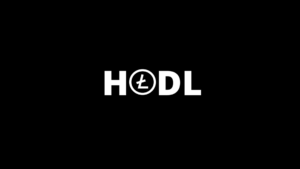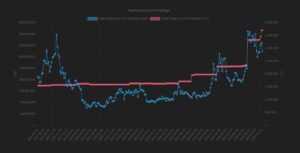Litecoin hit a significant milestone this week as it set a new all time high in payment transactions on the blockchain. Amidst various tailwinds for digital bearer assets, the development showcases both acceptance and growth trajectories of Litecoin as a viable store-hold of wealth and cross-boarder payment option without intermediaries.
Furthermore, the Litecoin halving scheduled for early August is expected to have a positive long-term effect on the fiat-value for the coin, driving adoption, investors, users and developers to the crypto.
One forecast indicates Litecoin could hit upwards of $8,000 by 2025.
Litecoin challenges the traditional system
Despite various online circles seemingly making it their life’s mission to talk down the cryptocurrency underdog, the fundamental value proposition for Litecoin has gained momentum. On Thursday, Litecoin registered an all time high of 167 million on-chain transactions, marking a momentous milestone in its payments adoption curve.
While also positioned as a store hold of wealth (digital silver), Litecoiners and developers have focused on challenging traditional payment mediums by making Litecoin more appealing as a medium of exchange.
By design, Litecoin has faster transaction times and lower layer one fees compared to Bitcoin. More recently, there’s been the launch of MWEB, a privacy-enhancing second layer solution which makes LTC more privacy-friendly, while markedly increasing fungibility. Earlier this month, coins on MWEB reached an all-time-high of approximately 365,000 LTC ($31.5mn), per block explorer data.
The figures build on various milestones reached in 2022. Metrics such as hashing power (network security), active and new addresses and underlying liquidity haven’t subsided throughout the downturn. To the contrary, Litecoin appears to have reached a critical mass of diehard users which use the crypto as sound money, per on-chain data by market intelligence platform IntoTheBlock.
Liquidity and market depth
Another vital component for good market functioning that has contributed to Litecoin’s increasing prominence is its deep liquidity. As the fourth most liquid cryptocurrency, per Kaiko data, LTC boasts robust market depth and trading volumes. This liquidity plays an important role in facilitating frictionless transactions, while also attracting a broader spectrum of customers, investors, enterprises, developers and users.
The high liquidity score means that there is enough buying and selling activity, making it easier for consumers to enter and exit positions without slippage. It also contributes to relative price stability, giving those who use Litecoin for payments or investment a better sense of security. Litecoin’s strong liquidity distinguishes it from other cryptocurrencies and boosts its market position.
Market depth and liquidity are also set to increase as traditional financial behemoths have dipped their toes into the sector. The new EDX exchange backed by finance giants Charles Schwab, Fidelity Digital Assets and Citadel Securities officially supports Litecoin as well as Bitcoin, Ethereum and Bitcoin Cash.
Expanding developer community
As briefly mentioned, development on Litecoin has increased, but LTC development has a history of resilience. In fact, the first SegWit and Lightning transactions were both first registered on Litecoin, and subsequently implemented on Bitcoin. In some crypto circles, LTC is sometimes referred to as a test-net for BTC, but with the launch of MWEB, the cryptocurrency has been forging its own personality.
The launch of non-fungible tokens (LTC20) on the blockchain has created another subset of economic activity that opens the door for increased usage and adaptability. Applications for decentralised finance (DeFi) are far-reaching for Litecoin given its 100% uptime track record. Broader application is a testament to the crypto’s versatility, openness to experiments and innovative use-cases, besides its core practicality which stems from extremely cheap fees.
Deflationary currency; finite supply
Every four years, Litecoin has a programmed deflationary event which cannot be altered. Come August 2023, the Litecoin halving is set to instantiate significant long-term effects on the protocol as the transition through its 3rd halving takes place.

During the halving, the block reward for miners is reduced by half, increasing scarcity. This means that the amount of newly created LTC per block is reduced, leading to a decreased supply of newly minted coins against a backdrop of increasing demand. The halving is hard-coded into Litecoin’s core code to ensure a controlled and predictable issuance schedule. It aims to maintain scarcity and prevent inflation, as the rate at which new coins are produced slows down over time. The previous Litecoin halvings took place in 2015 and 2019, with the next one expected in August 2023.
Typically, market sentiment surrounding the event is positive as investors and users anticipate the economic impact of a reduced supply issuance rate. One forecast based on the Network Value Model (NVM) available on TradingView by prominent market analyst Shan Belew is that LTC will reach $8,500 by 2025.
We can use a combination of the network growth bands of Litecoin compared to the Litecoin network value model cloud to get an idea of where Litecoin can trade around in 2025. Litecoin of course today is ridiculous cheap compared to where it can be in less than 2 years.
Targeting… pic.twitter.com/1FUWdiHLRW— Shan Belew Ⓜ️🕸 (@MASTERBTCLTC) June 23, 2023
The event serves as a reminder of Litecoin’s deflationary nature and finite supply of 84 million coins, which is not dependent on the whims of politicians or self-appointed financial overseers or government experts. This tends to contribute to LTC’s appeal as a store of value. Unlike coins such as Ethereum, whose monetary policy changes much like the US Federal Reserve changes its policy, Litecoin’s economic model follows principles of sound money, adding to its attractiveness as an investment asset.
Worth a buy?
All in all, Litecoin’s emerging strength underlines a growing appreciation that it is not merely an alternative side-show to Bitcoin, but a standalone cryptocurrency with a proven track-record of resilience and integrity. This is evidenced by the coin’s undeniable growth trajectory in core metrics.
However, due to its close brotherly relationship with Bitcoin, market participants appear to have been sitting on the fence, perhaps not realising that Litecoin is a younger crypto that’s just about to cross the Rubicon in terms of mass adoption (due to its 3rd halving event).
Regardless, the clock is ticking, Litecoin metrics are verifiably improving, be it in terms of underlying technology, market depth and liquidity, developer activity, usage or user growth.
Unlike decentralisation theatre paraded about by most projects which are potentially unregistered securities, Litecoin’s value proposition is in its integrity, decentralisation, network effects, technology and provably fair launch.
Join the telegram channel for updates, charts, ideas and deals.
Did you like the article? Share it!


